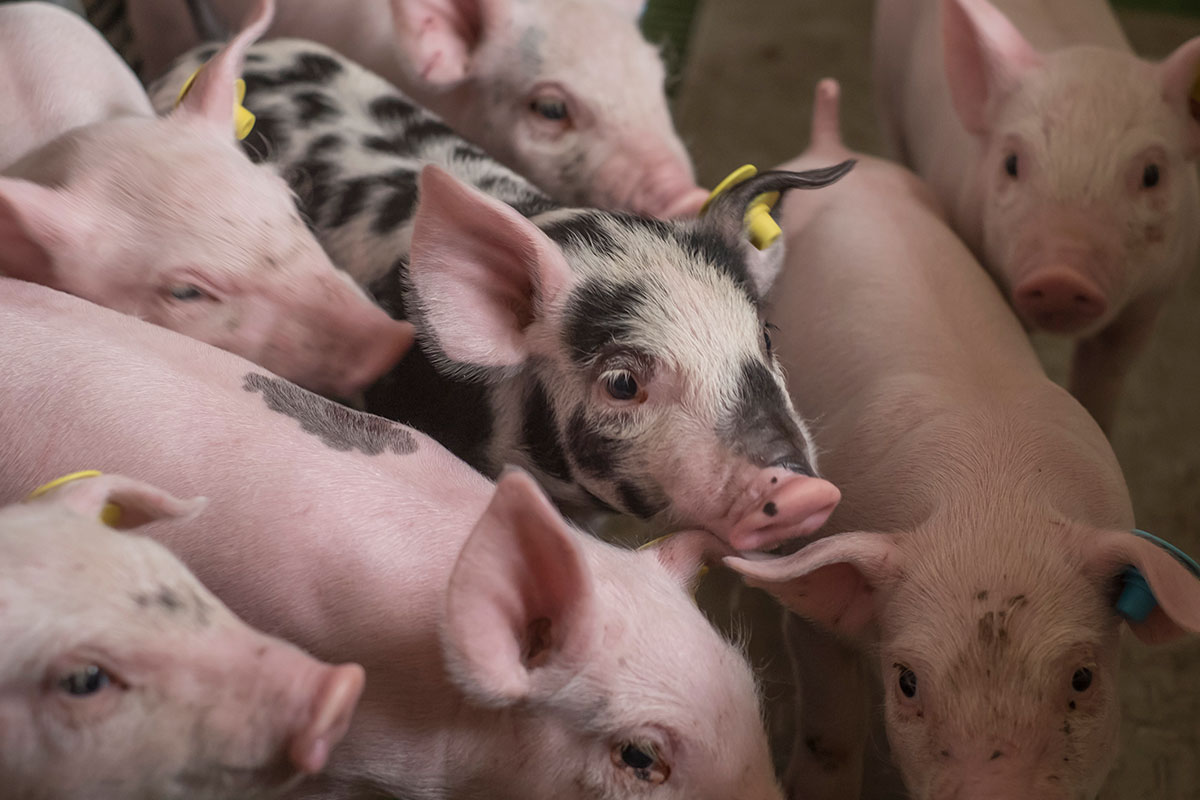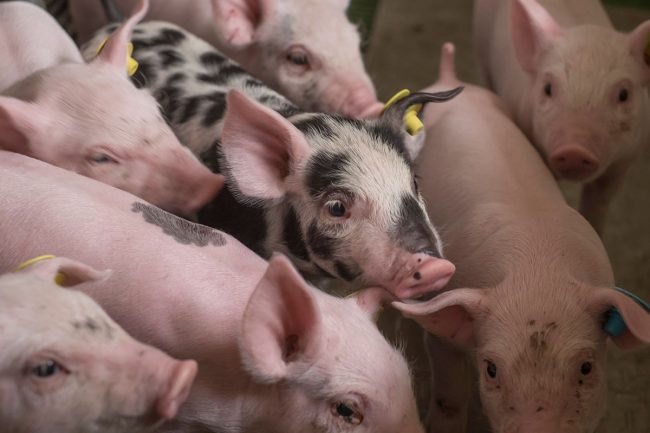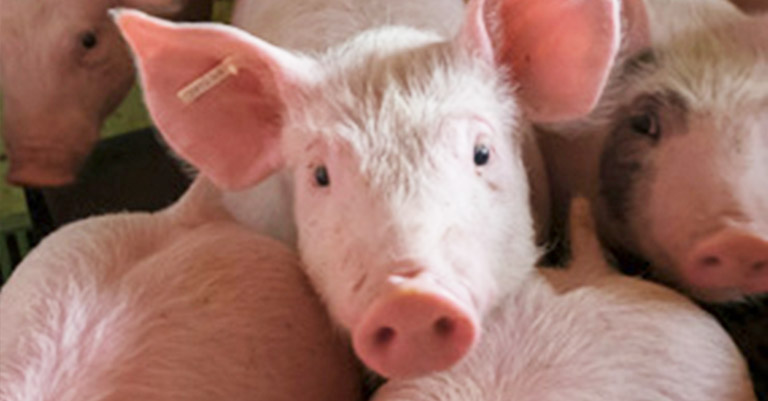
Find out the main concerns related to circovirus in pigs, as for example: diagnostics, maternal antibodies interference, moment of vaccination or administration routes.
Author: Alex Eggen
Vaccines that induce protection against porcine Circovirus Type 2 (PCV2) and Mycoplasma hyopneumoniae (M.hyo) represent the top 2 of most used vaccines in the swine sector. Unlike M.hyo vaccines, PCV2 vaccines have only been on the market for a relatively short time, since 2006. Now, 14 years after the first introduction of a PCV2 vaccine, the question may be asked what we have achieved in that time, and whether we can be satisfied with the results.
Vaccination against circovirus in pigs: a bull’s eye!
In 2006, there was a lot of discussion about the role of the porcine circovirus in the disease that was then called PMWS.
PCV2 virus was detected on farms with and without clear PMWS symptoms, such as pale, emaciated piglets with enlarged lymph nodes and sometimes skin bleedings, and high mortality.
However, within 6 weeks after the first use of the vaccine on farms with PMWS problems that discussion had ended.
Administering the vaccine to 3-4 week old piglets, where previous batches experienced 40-60% mortality before reaching the age of 10 weeks, was sufficient to silence these critics.
This huge reduction in mortality was the reason that the demand for PCV2 vaccines soared very quickly, and that the production was not sufficient to meet global demand until years later.
What was immediately noticeable from the start was that production factors on farms with a much lower mortality also improved after the introduction of a PCV2 vaccination. The question of why this improvement occurred received little attention. Farmers were just happy with it!
Or are there still question marks
Are there no doubts at all anymore about the use of porcine circovirus type 2 (PCV2) vaccines? Yes, there are doubts. Mortality is only part of the damage caused by the circovirus in pigs.
Growth retardation, a poorer feed conversion, and therefore poorer uniformity are important causes of economic damage caused by a PCV2 infection, even in the absence of high mortality or classic emaciated piglets. PCV2 vaccines are generally able to prevent this damage. It is however important that the vaccines are administered in the right way, at the right time and to the right animals. These choices should be made on the basis of biological and economic factors, and not on the basis of suspicion or convenience!
Conducting diagnostics and analysing production data are key factors in the optimal use of PCV2 vaccines. Vaccinating blindly at an age that happens to be convenient will in most cases help to prevent mortality and the classic PMWS symptoms, but does not necessarily give maximum returns.
The question whether subclinical PCV2 infections also occur is increasingly being asked, and the literature now shows that the answer is YES.
In subclinical infections no clear symptoms are visible in the herd, but pigs do develop an infection. The energy they require for fighting the infection cannot be used for growth.
As a result, a subclinical infection shall be visible in the technical results. Feed conversion and growth in particular shall be affected, resulting in a suboptimal performance of the pigs and a lower return on investment for the vaccine.
Diagnostics in the case of circovirus in pigs’ infection
To determine a PCV2 infection, the laboratory uses both serology, to detect antibodies, and the PCR technique to detect the Circovirus. The antibodies that are detected play a very important role in the protection against infection with PCV2 virus. These antibodies are called “virus neutralising” which means that they prevent the virus from entering a cell, where it can multiply.
Without multiplication, the virus quickly disappears from the body. For this reason the detection of the PCV2 virus is always important, both in vaccinated animals and in non-vaccinated animals. Namely the removal of the Circovirus is costing energy, and a pig gets that energy from the feed.
In the event that the vaccination does not provide adequate protection and some degree of PCV2 infection still occurs, this almost always results in economic damage. This phenomenon is called the “metabolic cost of infection.”
In other words, the better the vaccination is able to elicit protective immunity, the less chance there is of the occurrence of a PCV2 virus infection, and the associated metabolic and economic costs.
Maternal antibodies
The PCV2 vaccine is usually administered at a young age, to piglets that most of times have antibodies against PCV2. These maternal antibodies, which they receive from the sow, can adversely affect the effectiveness of a Circo vaccine.
This has to do with the fact that antibodies cannot distinguish between the PCV2 field virus and the antigen (the virus or part of the PCV2 virus) that is contained in a PCV2 vaccine; in both cases the antibodies have a neutralising effect.
For an optimal effect of a Circo vaccine, insight is therefore required into the titre of these maternal antibodies at the time of vaccination. This is easy to investigate using serology.
Follow-up of the vaccination
There are various options for determining whether the vaccination is working properly, through using diagnostics. The first option is to look at the antibodies.
Various scenarios are conceivable after vaccination. If piglets had a (relatively) low titre at the time of the vaccination, the level of antibodies will increase due to the vaccination, and they will therefore have a high(er) titre at the next sample taking. Piglets that still have high maternal titres at the time of vaccination will generally show a decrease, and therefore have a lower titre at the 2nd sample taking.
It is by far preferable that pigs have a high level of virus neutralising antibodies during the nursery and fattening phase. These antibodies prevent the virus from multiplying and thus save the body the energy it needs to fight the virus.
In the case of PCV2 cell mediated immunity also plays an important role.
Where antibodies work immediately from the start of an infection, and prevent virus replication, cell-based immunity does not start to work until there are infected cells, and the virus is already multiplying.
For that reason the metabolic cost of cell-mediated immunity is higher than those of immunity based on antibodies. Unfortunately, measuring cell-mediated immunity is more difficult and costly, and is therefore not routinely performed.

The second frequently used diagnostic option is the detection of PCV2 virus by means of a PCR. It will be clear from the above that it is undesirable to find any virus, even in vaccinated piglets.
If this is the case, the entire vaccination process will have to be examined more closely. This means that all steps must be thoroughly checked, from vaccine storage, needle length, dosage, route of administration, to timing of vaccination. The optimal vaccination strategy differs per farm and therefore always requires customisation.
Timing of the vaccination
The golden rule is that piglets should be vaccinated as late as possible to reduce the influence of maternal antibodies and as early as necessary to anticipate the expected field infection.
The package leaflet of a vaccine informs you from how long after vaccination protection is present. This is mostly after 3 to 4 weeks.
Based on information about the maternal immunity and the moment when the field infection occurs, an optimal moment of vaccination becomes clear. It could be that such an optimal moment is somewhat inconvenient, or at least differs from what was the norm.
However, to achieve a maximum “return on investment,” it is worth considering changing the time of vaccination.
Intradermal administration
In addition to the timing of vaccination the route of administration is also important for the effectiveness of the vaccine.
For some years now, in addition to the use in human medicine, intradermal (ID) administration of medicines and vaccines has also been used in veterinary practice. Why are increasingly more vaccines being introduced on the market that are administered ID? Well, very simple: because of the benefits for the animal and the user.
The benefits are many and in different areas. For example a needle can have the wrong length, become blunt or break. Needles used for different animals can transmit pathogens because the needle always comes in contact with blood. It may also be that the correct dose is not administered.
All aspects that do not play a role in ID administration. The dose (0.2 mL) that is used intradermally is only 10% of what is common for administration by needle.
ID injectors guarantee an accurate and reliable administration of the correct dose, without fatigue or unconscious human errors influencing this.

The effectiveness of vaccines administered intradermally is at least equal to the administration with the needle, because the same requirements are set for the registration of a veterinary medicinal product. Literature shows that cell-bound immunity in particular can be stimulated more strongly with ID vaccination.
The safety for humans and animals is better because only 10% of the intramuscular dose is used and no tissue damage occurs without a needle. In addition, with ID administration, the vaccine is directly brought into contact with the immune competent cells that are present in the skin, while when administered with the needle in a muscle, the immune competent cells must migrate towards the vaccine to initiate the immune response.
Given all these advantages it can be said that ID vaccination is the new standard, and the availability of ID vaccines will only increase in the coming years.
Maximizing returns
Insights change, new developments occur and the demands of the market are constantly increasing. Our world is dynamic and new technologies are becoming available all the time.
Where we were previously satisfied with the fact that PCV2 vaccination could prevent mortality and poor doers, we are now looking increasingly critically at the less conspicuous consequences of subclinical infections and suboptimal vaccination.
In order to achieve maximum return on the vaccination, it is important to review both the timing of the vaccination and route of administration. After all, you don’t have to be sick, to get better.


